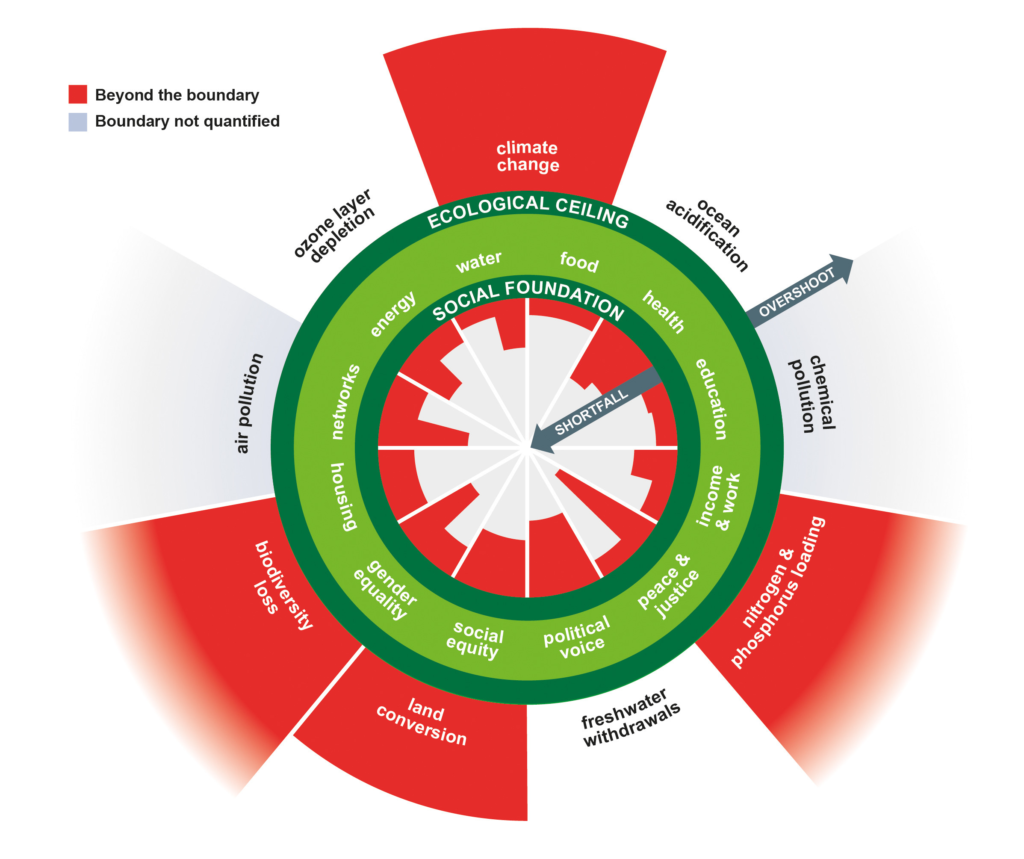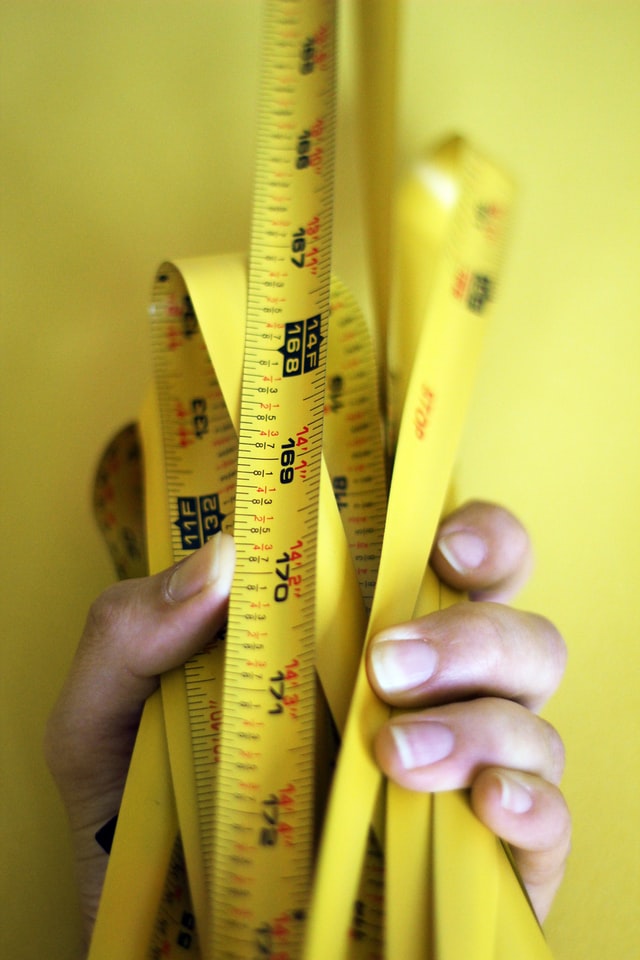
“Meeting the human rights of every person within the means of our life-giving planet.”
Kate Rawowrth in ‘Doughnut Economics’
that’s the intent and purpose of the Doughnut Economy.
And it is an aspiration that is as challenging as it sounds. Not only does it take the Plenary Boundaries, and which remain the best scientific approach of our planets overall carrying capacity, as its outer limit. But it also takes the social components of the Sustainable Development Goals (SDGs) as the guideline for what could be called humanity’s ‘prosperity needs’ as its inside delimiters.
All nice and well. Yet, not only is Doughnut Economic very different from any economic theory we have ever seen in modern history (in fact, it goes against the grain of most economic theories commonly respected and up until recently seen as ‘way to go’). But on top of that it is so new that we are still in the process of finding out how to implement it, – and how to measure progress against the Doughnut’s outer and inner boundaries.
In an earlier post I asked: How can business, a business, downscale the Doughnut and make it operational?
In this post I will look at three tools that praise themselves of being either part, or even all of the support a business needs on the journey to integrate the Doughnut Economics concepts.
The tools are:
- Science-based Targets (SBT)
- B Impact Assessment (BIA)
- Future Fit Business Benchmark (FFBBM)
But before I jump into the deep end, a word about all the tools that are not to be discussed such as: International Integrated Reporting, the SASB standards, the GRI, the CDP; or Fairtrade, regenerative organic; or SA8000, BSCI and others.
- International Integrated Reporting, SASB standards, GRI, CDP: Reporting is not progress. Standards such as those three are reporting standards. They are valuable for a fair status-quo comparison of businesses. But they are not very useful when it comes to benchmarking a business’ achievements against the inner and outer boundaries of the Doughnut.
- Fairtrade, regenerative organic, SA8000, BSCI: All of these standards are built to remedy – audit, correct – very specific environmental and/or social challenges. While progress is an intent of all of them, benchmarking against Doughnut Boundary is not within their realm.
Standards such as the above are useful as part of a set of tools to create progress in specific, limited and well-defined areas. Yet their ‘pass’ or ‘fail’ are not evaluated against the planetary boundaries we need to be benchmarking against, e.g. in a 2030 timeline.
It is for this reason that for this post I have chosen the only 3 tools I am ware of (happy to learn of others though …) that at least publicly claim to aim at progress by benchmarking against the Doughnut Economical principals and boundaries.

What are they? Science-based targets; B Impact Assessment; Future Fit Business Benchmark
- Science-based targets (SBT): are corporate science-based emissions targets, adopted by companies to reduce greenhouse gas (GHG) emissions, in line with what the latest climate science says is necessary to meet the goals of the Paris Agreement – to limit global warming to well-below 2°C above pre-industrial levels and pursue efforts to limit warming to 1.5°C.
- B Impact Assessment (BIA): is a free, confidential platform and questionnaire designed to help measure and manage a company’s (positive) impact on workers, community, customers and environment. The BIA assesses the impact of both a company’s day-to-day operations and its business model. Hence it looks at both: what is done do and how its being done.
- Future Fit Business Benchmark: Is a sustainability framework that intentionally enables companies to assess their progress towards goals that best-available science says any company must meet in order to be a truly in alignment with the Paris Climate Goals as well as the SDGs. It also includes challenges goals intended to speed up society’s transition to its future fit state.

3 Tools in Context: SDGs, Paris Agreement Trajectory, Planetary Boundaries
How do the above three tools compare to each other? What are the significant high-level differences? And what do we need to keep in our minds above and beyond this high-level comparison?
| Tool Name | Free | Who completes it? | Includes Financial Business Results? | Includes Governance | Contributes to SDGs | Uses Science-Based Goals |
| Future-Fit Business Benchmark (FFBB) | Yes | Self | No | No | All 17 | Yes |
| B Corp B Impact Assessment (BIA) | Yes | Self* | Yes | Yes | All 17 1 | Maybe2 |
| Science-based Targets (SBTs) | Yes3 | Self* | No | No | Some4 | Yes |
* Public claims require an audit and verification process
The differences that we can see in this high-level comparison are just as interesting as the similarities:
- Governance – in company structures as well as on boards – remains underrated, albeit being important in more traditional reporting tools such as e.g. the Global Compact.
- Even recognised best-in-class tools such as the BIA only align with Doughnut Boundaries if the user, i.e. the company filling it in, intends it so. By default such goals are not considered compulsory. This is a real issue given that the B Movement is quite vocally praising its positive impact on changing business models.
- Only the Future Fit Business Benchmark includes clear Doughnut-aligned scientific goals across all areas.
- SBTs do a good job in dealing with the GHG portion of the planetary boundaries, but ignore the others. It further offers 3 different methodologies, and some of those may potentially not be sufficient for meeting the actual scientific targets. Interestingly, SBTs can be used as a proof of delivery for the FFBBM.
- In terms of social inner boundaries, the call is still out. As it looks to me, BIA and FFBBM are by and large same-same. One is a bit stronger in one area, the other a bit more in another area. However, the FFBBM includes stretch goals that go – in my reading – beyond what the BIA is able to assess.
- Interestingly, the BIA does include a financial component – which is pushing towards the traditional growth paradigm. The B Movement also assumes that by replacing ‘bad companies’ with ‘good B Corps’ ultimately the growth Elephant-challenge will solve itself.
- FFBB does purpose exclude evaluation of financials, under the assumption that meeting Doughnut boundaries is the most important goal. Business models – whatever the definition of ‘success’ that comes with it – , and the respective governance, must fall within those boundaries. They theoretically may be growth based, but the chances are they won’t.
In many ways, a ‘typical’ BIA seems to be a very challenging regular check-up of the company. Somewhat akin to the yearly car fitness check-up compulsory in just about any Western Jurisdiction.
The FFBBM then adds to the challenge by making the Planetary Boundaries an absolute measurement threshold. It is for a very serious company a more scientific and goal driven work tool towards a 2030 (or even 2050) timeline.
Further Reading
- Bob Willard, Sustainability Advantage,
-> Science-based ESG reporting tools
-> Comparison of 12 Sustainability Frameworks - SDG Action Manager: A Collaboration by Global Compact and the B Impact Assessment
- Future Fit Business Benchmark and the SDGs: An Overview
Footnotes:
1 In the SDG action manager however, focus areas are chosen depending on the industry a business is active in.
2 Some questions have a necessary science-based goal as the highest level of performance in the pick list.
3 The Methods are public in principle. Publicly claimed SBTs have to be go through a review and validation process with experts.
4 SBTs are focused on GHG emissions., and therefore SDG 13 and 7.

